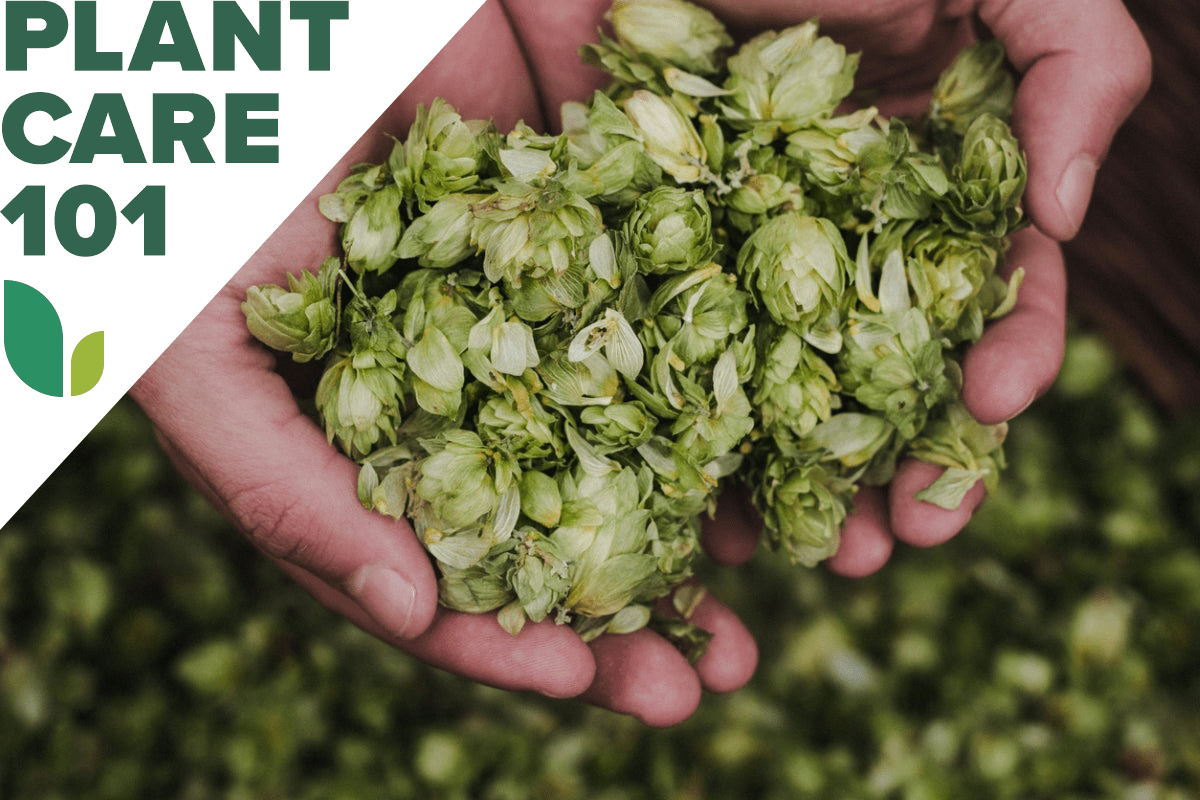We may earn revenue from the products available on this page and participate in affiliate programs. Learn More ›
Learning how to grow hops isn’t difficult. In fact, it’s a little too easy—one of the only plants that grows faster than hops is bamboo. So if you don’t confine your hops bines (climbing stems) to a vertical structure, they’ll show the wolf in their Humulus lupulus species name by “eating up” other nearby plants.
Hops are most often grown for their cone-shaped strobiles, which are used in home beer brewing for flavor and aroma, or by herbalists to stuff sleep pillows. However, the same vines can serve as a decorative covering for pergolas, and the young shoots are excellent climbing vegetables. Additionally, Japanese hops can be grown purely for ornamental purposes in some U.S. regions, but this type is invasive to natural areas like waterways.
Growing Hops at a Glance
Common Name: Hops
Scientific Name: Humulus lupulus, H. japonicus (ornamental species)
Hardiness Zone: 4 to 9
Soil: Well-draining sandy loam
Light: Full sun
Water: Plentiful
Food: Low-phosphorus or nitrogen-only fertilizer
Propagation: Layering or seed
Safety: Edible but prickly
Hops Plant Characteristics
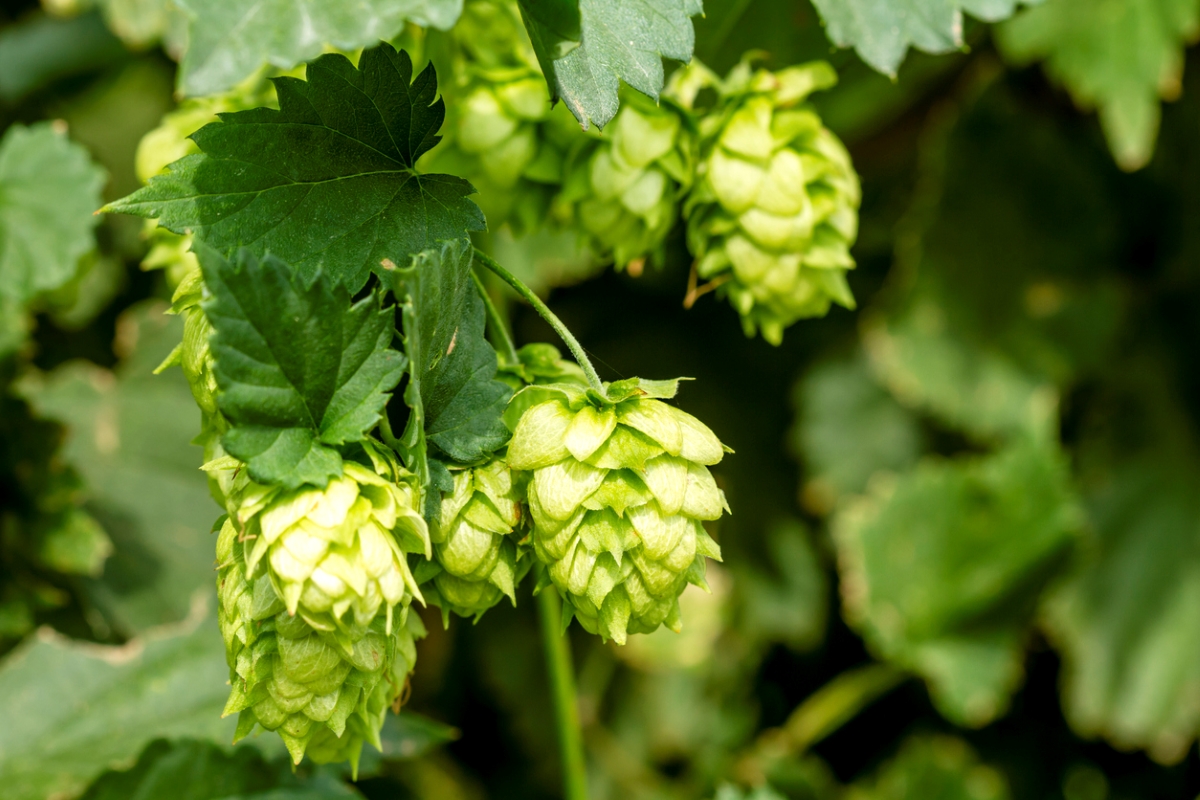
Scratchy in texture with lobed leaves, a hops beer plant climbs 15 to 25 feet over the course of one summer. It does most of that scrambling early in the season, after which it branches out to produce papery green cone-like strobiles—varying from ¾ inch to 2 inches long—in late summer or early autumn. The plant’s bines die back to the ground over winter, but the rhizomes are hardy in USDA zones 4 through 9 and send up new shoots the following summer.
Make sure that any plants you purchase to produce hops are female rather than male, since the male plants only produce clusters of the inconspicuous greenish-white hops flower and aren’t required for hops production. Because the vines need long summer days, at least four frost-free months during summer and a month or two of chilly (below 40-degree) weather during winter, they grow best in latitudes between 35 and 55 degrees.
Recommended Hops Varieties
- Humulus lupulus: Common hop plant grows to 30 feet, bearing three- to five-lobed leaves up to 6 inches across and 1- to 2-inch-long hops. This type can supply the hops used in beer.
- Humulus lupulus ‘Aureus’: This more colorful cultivar of common hops has chartreuse (yellow-green) foliage in spring that may darken during summer.
- Humulus japonicus: Japanese hop grows from 20 or 30 feet with five to seven-lobed leaves and ¾-inch-long hops. It is grown for ornamental value, but is invasive in areas of the Northeastern and Midwestern U.S. and can choke out native plants.
- Humulus japonicus ‘Variegatus’: This decorative cultivar derives from the species above, boasting both flowers and foliage splashed with white variegation.
Planting Hops
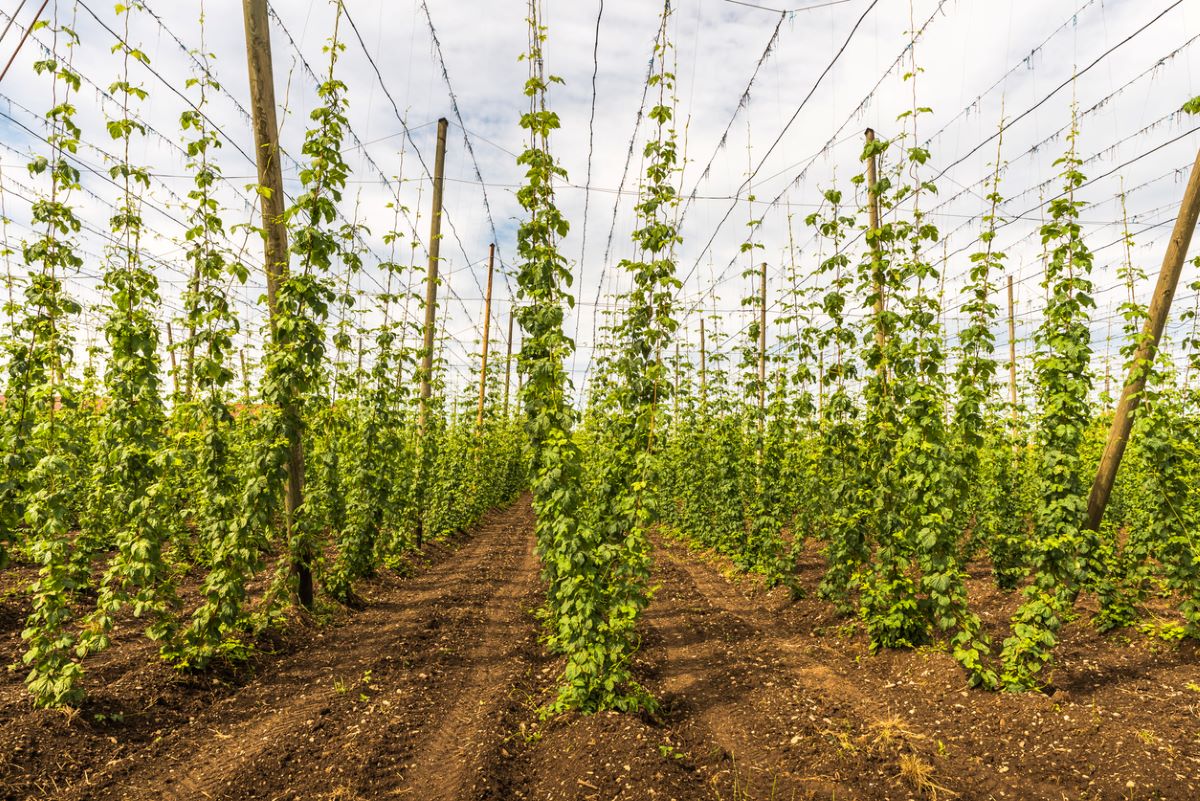
When growing hops in a backyard, you might want to train them over arbors or pergolas rather than on the wire trellises mentioned below for a better aesthetic.
When is the best time to plant hops?
Plant hops in spring, after all danger of frost has passed. In subsequent years they will pop up when the weather warms to their liking. Keep in mind that hops vines require time for their rhizomes to become established so they may not grow as rapidly above ground or fruit during their first year as they will once the rhizomes mature.
Where can hops grow?
Choose a location in full sun which has loamy soil with a pH between 6 and 7 and a support on which the vines can climb. Commercial growers typically construct trellises from very tall posts with a horizontal wire strung across their tops. The hops vines climb lengths of heavy twine secured to that wire and to small stakes in the ground.
How do you plant hops?
Keep dormant hops rhizomes refrigerated until you are ready to set them out.
- Plant the rhizomes in hills spaced 2 to 3 feet apart.
- For each hill, dig a hole large and deep enough for two of your rhizomes, positioning them horizontally with their buds up and covering them with 1 inch of soil.
- When transplanting plants from pots instead, place one of them per hill at the same height they grew in the pot.
Can you grow hops in containers?
Hops vines won’t produce to their full potential in pots, but it is possible to grow them there. Make sure the container is at least 20 inches across or—even better—a half barrel. You’ll also need to provide a tall stake or pot trellis on which your plant or plants can climb.
Watering Hops
Because they grow so rapidly, hops require larger amounts of water than most crops, preferably about 1½ inches per week. However, you should never allow their soil to become soggy. Use a watering method such as drip irrigation, which avoids splashing the leaves; hops vines are prone to fungal diseases when their foliage stays wet.
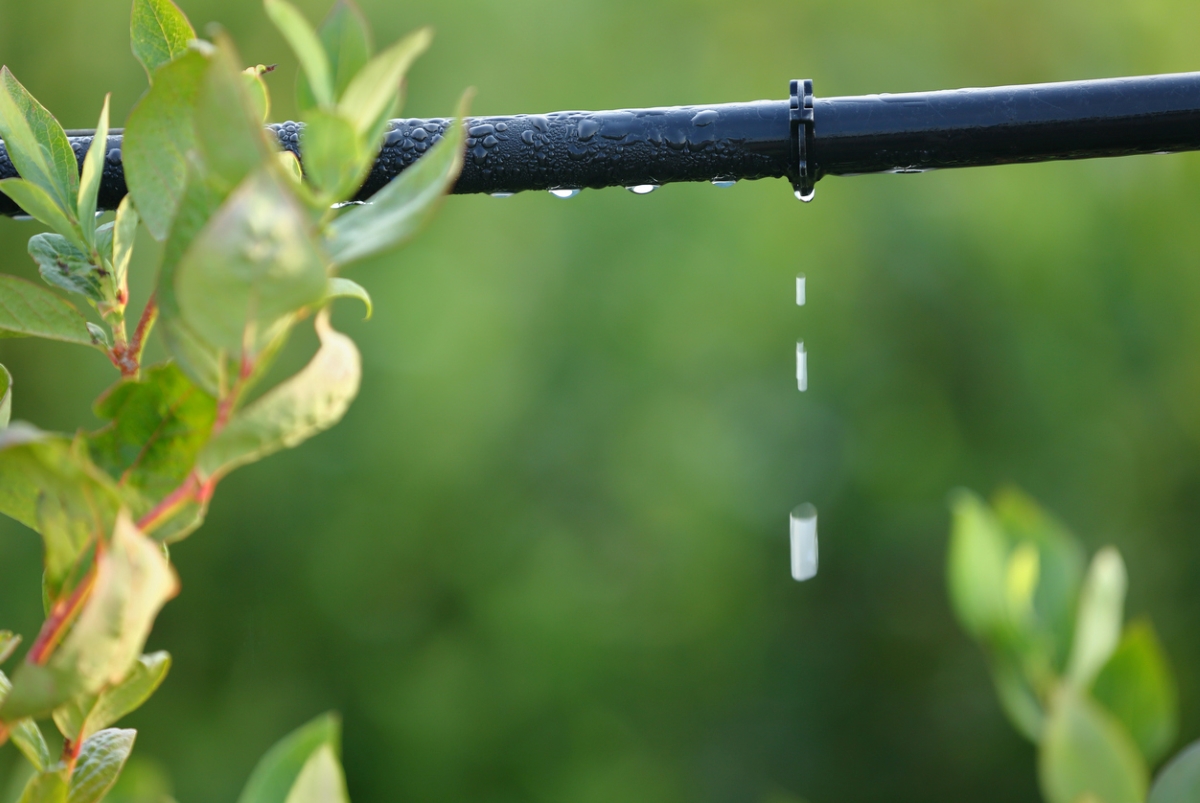
Fertilizing Hops Plants
Since a hops plant doesn’t require much phosphorus, it’s a good idea to use a fertilizer in which the middle number of the formula is the lowest one to prevent the polluting runoff caused by an excess of the mineral. Alternatively, try a nitrogen-only plant food, applied once every 2 weeks from mid-April until mid-July. Since a hops vine completes most of its yearly growth during these months, it shouldn’t need further supplementation after that point.
Pruning Hops
Once your vines’ shoots have reached 1 foot high, snip off the weakest ones, leaving the strongest three on each rhizome. Train those remaining to climb on a support in a clockwise direction, positioning no more than three vines on a single twine. That is all of the pruning you need to do for first-year plants.
In midsummer of the second year, you might want to snip off the foliage on the lowest 3 to 4 feet of your vines. That helps prevent fungal diseases, but shouldn’t affect the crop, which typically appears at the top of the trellis.
Propagating Hops
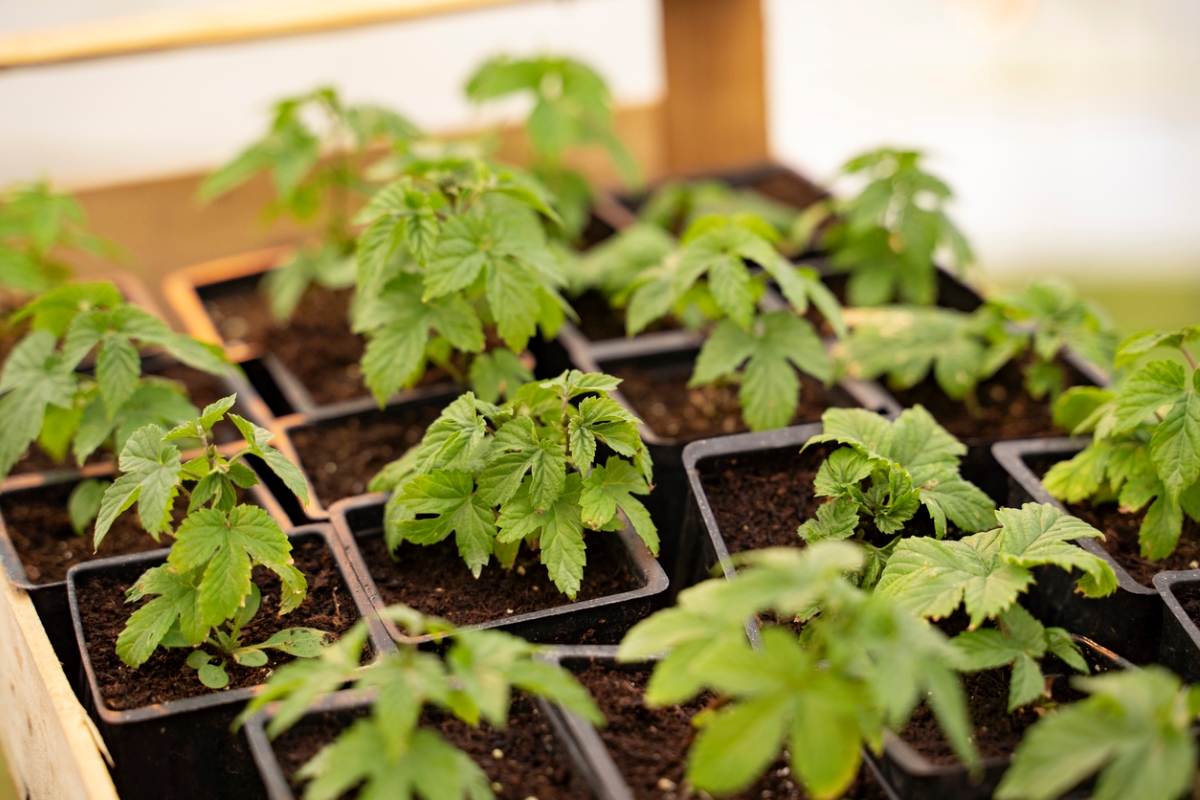
Although you can propagate hops from seeds, the plant’s characteristics might not be the same as those of the parent plant and you cannot control whether the seedling will be a male or female plant. Before planting hops seeds, mix them with a little damp sand and place them in a covered container in your refrigerator for 3 months. Then sow them ⅛-inch deep in damp seed starting mix and keep them at 68 degrees Fahrenheit. They may take 4 to 6 weeks to germinate.
To root more hops at the end of harvest season, simply dig a shallow trench beside the plants and lay the vines—still attached to those plants—inside it. In the spring, unearth those vines and snip them into 4-inch sections, each of which should have a bud.
Safety Considerations
When handling a hops vine or hops leaves, you’ll want to cover up well, since the plants’ hooked hairs can inflict a rash on exposed skin. Also, according to Cornell Cooperative Extension, “Hops are high in natural estrogen and some precaution may be necessary for pregnant women such as wearing gloves.”
If you intend to set up tall 15-foot trellis on wood posts for commercial growing, make sure that their bases are planted 3 to 4 feet deep in the ground to prevent any possibility of their toppling from the vines’ weight.
Potential Pests and Diseases
Unfortunately, the hops plant has its very own downy mildew disease. Suspect this malady when new shoots emerge brittle or pale in color with deformed leaves. To help prevent that, plant resistant varieties such as ‘Fuggle’ and ‘Tentnag’.
Another fungus disease, a hops-specific powdery mildew, can cause deformed strobiles as well as a gray powder on the surface of the foliage. To ward off that problem, purchase disease-resistant cultivars such as Crystal and Cascade and prune off the lower leaves of mature plants as described under “Pruning Hops” above.
Harvesting Hops
If you are growing hops vines simply for their decorative value, you’ll probably want to leave the strobiles in place.
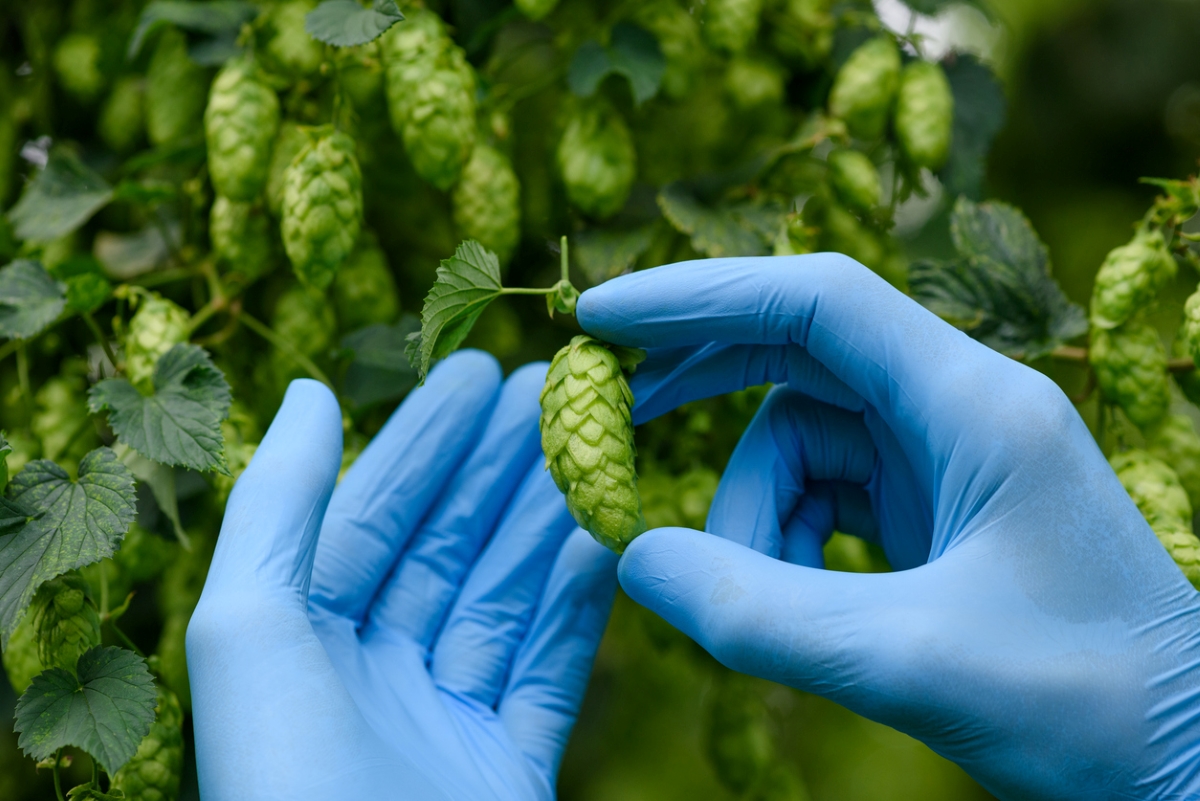
When is the best time to harvest hops?
Harvest your hops in mid-August to mid-September once they are dry enough that, when you squeeze one between your fingers, it doesn’t stay compressed but opens back up. Also, the powdery lupulin “dust” shed by those hops should be fragrant and have turned from pale yellow to a more golden color.
How do you harvest hops?
These instructions for picking hops assume that the vines are growing on twines on a tall trellis with a top wire and will need to be cut down.
- Spread a tarp beneath the hops vines
- Use a pole hedge trimmer to cut off the twines and the vines growing on them about 3 feet above the ground.
- Then cut the twines near their apex, just under the trellis’s top wire, so that the vines fall onto the tarp.
- Pick the hops off the vines by hand, wearing gloves for the process.
How do you store hops?
Dry hops in a food dehydrator in which the temperature doesn’t surpass 140 degrees Fahrenheit. Alternatively, spread them over screens laid horizontally atop sawhorses or other supports in a protected location, turning them frequently. Once they have dried to the point that the stems at the centers of the cones snap easily rather than bending, pack your hops into zip-type plastic freezer bags so they are airtight, and freeze them until you need them for home-brewed beer, cooking, or aromatherapy.
Looking for more vining plants? Check out our guides on growing morning glories, sweet potatoes, and wisteria.

